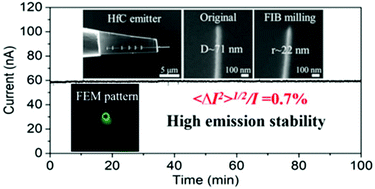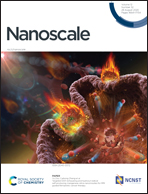A controllable and efficient method for the fabrication of a single HfC nanowire field-emission point electron source aided by low keV FIB milling
Abstract
A single hafnium carbide (HfC) nanowire field-induced electron emitter with a sharp tip apex is fabricated by Pt deposition and focused ion beam (FIB) milling. The structure of the electron emitter is characterized by scanning transmission electron microscopy (STEM) and atom probe tomography (APT). The HfC nanowire is single-crystalline with a thin oxide layer on its tip surface. The field emission properties are determined by using both in situ transmission electron microscopy (TEM) and a field-emission probe in a high-vacuum chamber. A high current of 173 nA was obtained at a low extraction voltage of 631 V with an emission gap of 5 mm. The emission current is stable at 60 nA for 100 min with a fluctuation of 0.7%. The deduced work function was 3.1 eV. It is suggested that the implanted Ga ions and the oxide layer induce more downward dipoles that are beneficial for lowering the work function and creating a stable surface. When the low keV FIB processing is applied, it takes within 30 minutes to finish a HfC nanowire emitter, establishing an efficient procedure for the preparation of nanowire emitters. These results provide a controllable and fast production method for the fabrication of single nanowire field-emission point electron sources.



 Please wait while we load your content...
Please wait while we load your content...